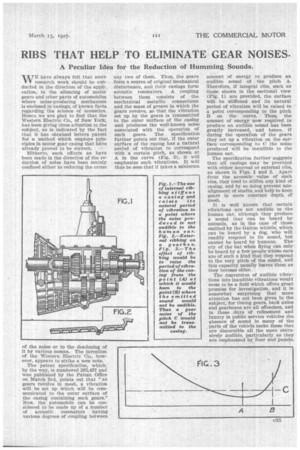RIBS THAT HELP TO ELIMINATE GEAR NOISES.
Page 57

If you've noticed an error in this article please click here to report it so we can fix it.
A Peculiar Idea for the Reduction of Humming Sounds.
WE have always felt that more research work should be conducted in the direction of the application, to the silencing of motor gears and other parts of automobiles where noise-producing mechanism is enclosed in casings, of known facts regarding the science of acoustics. Hence we are glad to find that the Western Electric Co., of New York, has been giving close attention to the subject, as is indicated by the fact that it has obtained letters patent for a method which employs principles in motor gear casing that have already proved to be correct.
Hitherto, such efforts as have been made in the direction of the reduction of noise have been mainly confined either to reducing the cause of the noise or to the deadening of it by various means. The invention of the Western Electric Co., however, appears to strike a new note.
The patent specification, which, by the way, is numbered 265,437 and was published by the Patent Office on March 3rd, points out that "as gears revolve in mesh, a vibration will be set up which will be communicated to the outer surface of the casing containing such gears." Now, the automobile can be considered to be made up of a number of acoustic resonators having various degrees of coupling between any two of them. Thus, the gears form a source of original mechanical disturbance, and their casings form acoustic resonators. A coupling between them consists of the mechanical metallic connections and the mass of grease in which the gears revolve, so that the vibration set up by the gears is transmitted to the outer surface of the casing and produces the well-known noise associated with the operation of such gears. The specification further points out that, if the outer surface of the casing has a natural period of vibration to correspond with a certain pitch, as shown at A in the curve (Fig. 3), it will emphasize such vibrations. It will thus be seen that it takes a minimum
amount of energy to produce an audible sound of the pitch A. Therefore, if integral ribs, such as those shown in the sectional view (Pig. I) are provided, the surface will be stiffened and its natural period of vibration will be raised to ' a point corresponding to the pitch B on the curve. Thus, the amount of energy now required to produce an audible sound has been greatly increased, and hence, if during the operation of the gears they set up a vibration on the surface corresponding to C the noise produced will be inaudible to the human ear.
The specification further suggests that all casings may be provided with either internal or external ribs, as shown in Figs. 1 and 2. Apart from the acoustic value of such ribs, they tend to stiffen any kind of casing, and by so doing prevent misalignment of shafts, and help to keep gears in more constant depth of mesh.
It is well known that certain vibrations are not audible to • the human ear, although they produce a sound that can be heard by animals, as in the case of those emitted by the Gallon whistle, which can be heard by a dog, who will readily respond to its sound, but cannot be heard by humans. The cry of the bat when flying can only be heard by a few people whose ears are of such a kind that they respond to the very pitch of the sound, and this capacity usually leaves them as they become older.
The conversion of audible vibrations into inaudible vibrations would seem to be a field which offers great promise for investigation, and it is somewhat surprising that more attention has not been given to the subject, for timing gears, back axles and gearboxes are all offenders, and in these days of refinement and luxury in public service vehicles the absence of sound in many of the parts of the vehicle make those that are discernible all the more obtrusively audible, particularly as they are emphasized by floor and panels.












































































































